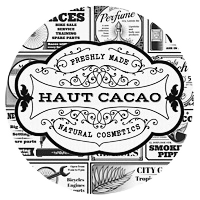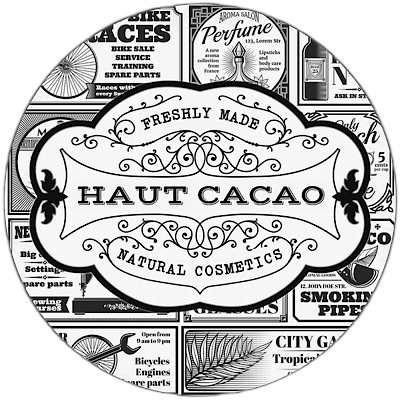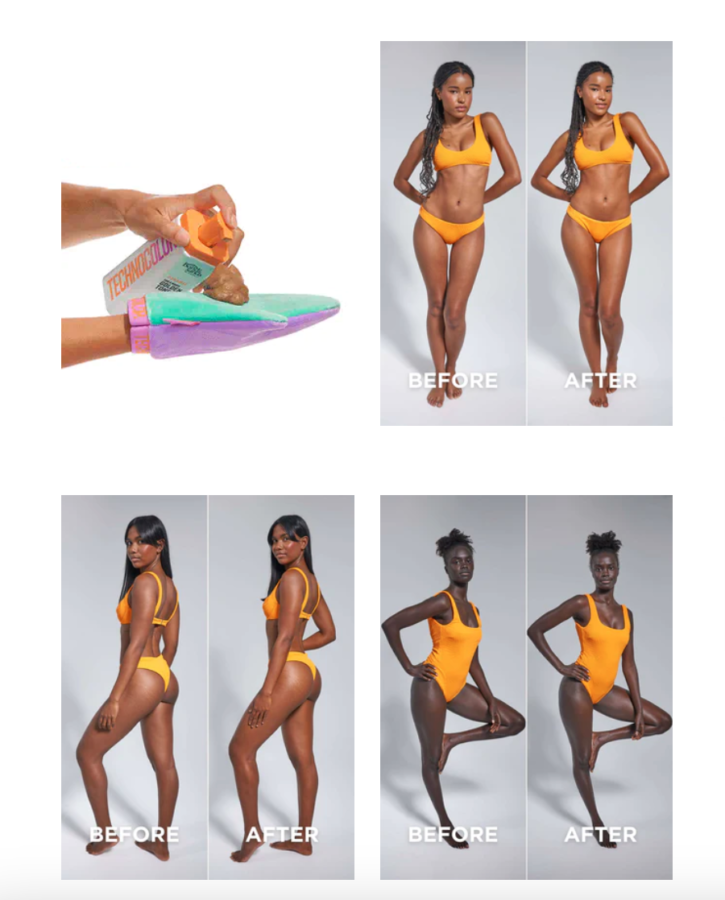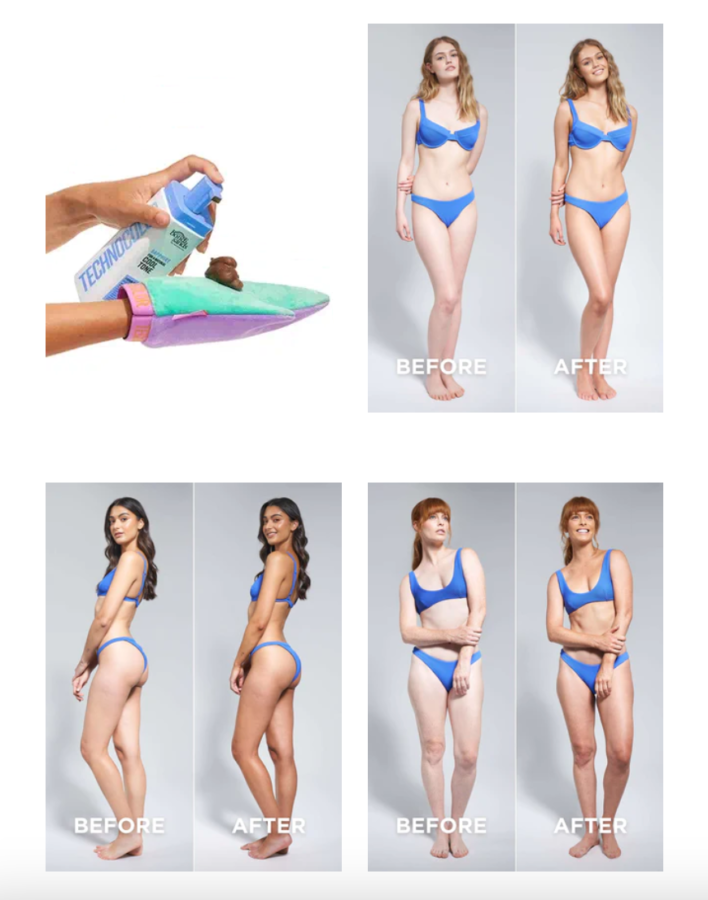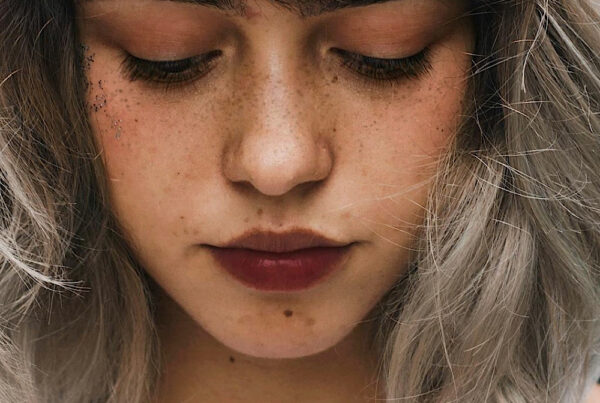What can be confusing when choosing a self tanner is choosing the right colour for you. Often you see reviews where a self tan product is being swatched to compare with other self tan products from other lines. The instant colour you will see is not the active tanning agent DHA, it could be the ingredients caramel, mineral pigments, or lake dyes. The lake dyes will actually work differently than the natural bronzing ingredients. These dyes are used to dye fabrics, easter eggs, processed foods and drinks, and many other things. They can also dye the skin. A freezie can dye the inside of your mouth and lips in the same way because the same dyes are used and they are absorbed into the skin cells. The colour of the self tanner dye on the skin will be intense, sometimes almost a green/brown, like a shadowy tone, sometimes a more rich dark brown and at other times almost a brown/black or green/black, and different than the developing DHA colour on the skin. The two varying shades tend to overlap. Because the lake dyes can still dye the skin, they will change the look of the DHA colour that develops in the first 8 hours. After a couple days, only DHA is left on the skin, as the dyes disappear first. The DHA by itself is a more rust-orange tone. Eventually the dyes wear off completely and only the DHA stain is left to wear off on the skin after that. Here is an example, though the actual depth of the colours are much more intense in real life than in videos and photos:
synthetic self tanner product testing
food colouring = petroleum-based dyes
dyes = animal testing
all synthetic dyes including Red 40, Yellow 5, blue 1, and Yellow 6 are tested on laboratory animals. While the dye itself is tested on animals, it’s important to note that the cosmetics and personal care products it’s used in may or may not be tested on animals as well.
food colouring as lipstick
food colouring as lipstick video 2
what a mess
the whole situation can get really messy. And when the situation is happening on your face, it can get even messier. When lake dyes/food colouring are being applied, even in a diluted version, it can leave a stain that turns blotchy or streaked after a few days. So then you either need to aggressively exfoliate your face, or cover up the spots with makeup. Even with dye-free self-tanners, I was often left with stained clothes, sheets, and pillowcases. That is why I opted for 100% no bronzer or tracer colour with my own self tanner, the caramel tan, and instead I whip my coconut based formula so that you can use the slightly white tone to see where you need to blend the product in a little more. As I mentioned in the previous post, I love Cara’s artistic shading technique except that she is using the petroleum-based dyes. I also do not think the majority of us have the time and advanced colour correction and contouring knowledge to be able to do what she is doing in this tutorial video below. In the above videos, dyes are being applied to the skin in a more dramatic or intense way. Cara applies dyes like tiny little pixels and then gently taps them to make sure they are pressed and absorbed into the skin precisely where she placed them. You would not want to embark on this process without really good natural lighting either.
self tanner as demi makeup by cara
There are some self tanners which seem to have a higher amount of synthetic dyes added to enhance or counteract the orange-red DHA tone. Keep in mind that DHA, the most common active tannng agent in self tanning formulas is always one colour in different levels or depths. It will always be a red-orange tone. So, to customize a self tanner further for a wider range of skin tones, there are companies which are creating products that are less DHA and more synthetic dyes. This means their formulas will dye you like an an easter egg. Makeup artist are taking it a step further and using these products like makeup so that their makeup lasts for days.
I am also wondering if some of these companies are trying to bump up the colour of their formulas by increasing the percentage of synthetic dyes. If they are regulated under the EU, the new regulations for DHA-based self tanners as of 20222-2023 is that companies have to reduce the percentage of DHA in a product for health and safety reasons. This is a problem for many companies who were 5-10% over the new maximum percentage. So companies in the EU have been scrambling to figure out how to maintain an intense depth of colour in their darkest formulas.
love at first tan base tanner ingredients:
Aqua (Water), Propylene Glycol, Dihydroxyacetone, PEG-6 Caprylic/Capric Glycerides, Caramel, Dihydroxypropyl PEG-5 Linoleammonium Chloride, PEG-7 Glyceryl Cocoate, Phenoxyethanol, Caprylyl Glycol, Potassium Sorbate, Hexylene Glycol, Argania Spinosa (Argan) Kernel Oil, Macadamia Integrifolia (Macadamia) Seed Oil, Cocos Nucifera (Coconut) Oil, Simmondsia Chinensis (Jojoba) Seed Oil, Rosa Canina (Rosehip) Fruit Oil, Vitis Vinifera (Grape) Seed Oil, Persea Gratissima (Avocado) Oil, Cucumis Sativus (Cucumber) Fruit Extract, Ascorbic Acid (Vitamin C), Tocopheryl Acetate (Vitamin E), Blue 1 (CI 42090), Red 40 (CI 16035), Yellow 6 (CI 15985), Green 5 (CI 61570), Yellow 5 (CI 19140), Red 33 (CI 17200).
Bondi Sands Technocolor 1 Hour Express Self Tanning Foam (in various synthetic dye based shades)
caramel – golden tone
AQUA (WATER), DIHYDROXYACETONE, PROPYLENE GLYCOL, TRIDECETH-9, POLYSORBATE 20, PEG-5 ETHYLHEXANOATE, GLYCERIN, ETHOXYDIGLYCOL, SODIUM HYALURONATE, ALOE VERA CALLUS EXTRACT, COCOS NUCIFERA (COCONUT) WATER, PEG-12 DIMETHICONE, PEG-12 ALLYL ETHER, PEG-12, DISODIUM EDTA, ETHYLHEXYLGLYCERIN, PANTHENOL, CI 19140 (FD&C YELLOW NO. 5), CI 14700 (FD&C RED NO. 4), CI 42090 (FD&C BLUE NO. 1), CI 17200 (D&C RED NO. 33), PHENOXYETHANOL
sapphire – cool tone
AQUA (WATER), DIHYDROXYACETONE, PROPYLENE GLYCOL, TRIDECETH-9, POLYSORBATE 20, PEG-5 ETHYLHEXANOATE, GLYCERIN, ERYTHRULOSE, ETHOXYDIGLYCOL, ALOE VERA CALLUS EXTRACT, COCOS NUCIFERA (COCONUT) WATER, PEG-12 DIMETHICONE, PEG-12 ALLYL ETHER, PEG-12, DISODIUM EDTA, ETHYLHEXYLGLYCERIN, PANTHENOL, CI 14700 (FD&C RED NO. 4), CI 19140 (FD&C YELLOW NO. 5), CI 42090 (FD&C BLUE NO. 1), PHENOXYETHANOL.
This bondi sands product also comes with a warning:
KEEP OUT OF THE SIGHT AND REACH OF CHILDREN. FOR EXTERNAL USE ONLY. Carry out a patch test on the forearm 24 hours prior to use. Do not apply to damaged or inflamed skin. If irritation, redness or itchiness occurs, discontinue use. If swallowed, get medical attention or contact a poison control centre right away. Keep away from eyes & lip. If material accidentally enters the eye or contacts lip, rinse well with plenty of clean water. Seek medical attention if irritation persists.
In the video below you will see the difference in colour. The first colour that shows when she is applying the product is likely lake dyes because of how intense the colour is on her skin. Then, the stain you see on the inside of her palms where she applied the colour is the DHA colour, and it takes days to wear off. The ‘tan’ takes the same amount of time to wear off in other areas so if you want to be consistently tanned-looking, you can never really get rid of the ‘dirty palms’ look. This will be the same when applying self tanner to the face. DHA is a more intense colour than the active ingredient I use in my formula. Because of this, DHA does not leave a lot of room for mistakes, and if you are going to be applying your self tan to your face, there is even less margin for error. Because we wash and exfoliate our faces more than any other area of our body, the DHA has the ability to develop much more on the face than the body. It is easy to go too dark and then you will be left with a dirty-looking colour and possibly uneven blotches or streaks of colour on your face.
why I think the standard self tanner is too high maintenance + way too messy video
is DHA aging to the skin?
There has been concern lately with DHA or Dihydroxyacetone causing premature aging to the skin. This is just my personal opinion but there are a few common self tan ingredients I would be concerned about when it comes to premature aging of the skin, the least of those being DHA. Many formulas contain a lot of chemical fragrance or ‘parfum’. to mask the odour created from the DHA. This one ingredient can include more than 300 different chemicals and none are required to be listed in the full ingredients. So already, you are applying a mystery soup of chemicals to your skin and allowing them to be absorbed into your bloodstream. Aging starts on the inside and works its way out, not the other way around. There is even a chance that these ingredients could get into your eyes. Also, the alcohols which are needed to formulate a DHA-based formula can sometimes irritate the skin. Another ingredient many self tan formulas contain is glycerin or glycerine. Even if it is vegetable-based, many companies selling glycerin, even relatively good companies that I contacted, are selling unsafe glycerol from GMO soy or other such industrialized crops! Also note, many sources of glycerine/glycerol are now synthetic and the process used to make it involves all sorts of not-so-natural-looking chemicals and processes as described above. Stay away from artificially synthesized glycerol with the potential for toxic residues.
what you will notice if you use my caramel tan formula as makeup
You will notice a lot of skincare properties along with the increase in vibrant colour. The active tanning ingredient, which is a sugar from a raspberry is believed to promote the production of collagen. Collagen is an important protein that maintains the elasticity and firmness of the skin, and the application of this fruit sugar can stimulate the synthesis of collagen in the skin to a certain extent, making the skin more elastic and slowing down the process of skin sagging and aging. Also, DHA-based self-tanners only last a few days. My caramel tan will last 7-10 days so you do not have to apply it as often. There is no odour like with the DHA-based formulas and the formula is scent-free, including essential oils. There is a slight difference in the colour that develops. A DHA-based tan has more of a rust-orange colour to it. My caramel tan creates more of a golden amber tone. Both will vary depending on the skin tone. When the natural wearing-off process begins, DHA can start to look a little streaky or blotchy, especially on someone who is more fair. My formula wears off more slowly and evenly and also leaves a glowy look to the skin.
1. Worst Ingredients in Self Tanner: Alcohol (ethanol)
Many self tanners contain alcohol because it’s a great solvent for dyes. And, yeah, dyes are a BIG part of how most self tanners achieve the tan (as your white towels know all too well). The problem is, it can cause skin irritation and cell damage.
Why avoid alcohol in your self tanner
Alcohol has been known to dry out the skin by removing water from the top layer of skin cells. This can lead to cracking, chapping, flaking…and even bleeding! See what I did there? Blood in self tanner is never a good thing. It may cause you to look like an extra on The Walking Dead.
What to look for on the label:
Watch out for gentle sounding names of alcohol, such as Cetyl Alcohol, Stearyl Alcohol, Lauryl alcohol and cetearyl alcohol – they are all potentially skin-damaging.
2. Worst Ingredients in Self Tanner: (vegetable) glycerin
Synthetic glycerin is very commonly used in industry nowadays. It is a complex process that may begin with substances such as allyl chloride, acrolein, propylene oxide, polyalcohols, fats, or epichlorohydrin. Some of these chemicals are quite dangerous. Allyl chloride, for example, causes toxic polyneuropathy (multiple nerve damage) with prolonged exposure.
Why Avoid glycerin (vegetable included) in Your Self Tanner
Another way to synthetically create glycerol is to oxygenate propene to acrolein, reduce it to yield allyl alcohol, and then epoxidate it with hydrogen peroxide. That creates glycidol, which industry hydrolyzes to produce glycerin. Sound complicated? It is! It is primarily from these artificial glycerols that the potential for toxic residues and health dangers occurs.
What to look for on the label:
Look for names like glycerin, glycerine, vegetable clycerine, or even glycerol.
3. Worst Ingredients in Tanner: Fragrance
Ah, fragrance. We all love a sweet, gentle scent. And when it comes to most stinky self tanner formulas, we’d love a nice scent all the more! Unfortunately, “fragrance” is really an umbrella term used by companies to conceal a laundry list of uglies.
Why Avoid Fragrance in Your Self Tanners
On the product label, you’ll see “fragrance.” But what many companies are actually using is a chemical cocktail that can include all sorts of ingredients, such as Alpha-Hydroxy Acids (like lactic and glycolic acid), Dihydroxyacetone, Parfum or Fragrance, Limonene or Linalool, Benzyl Benzoate, Coumarin, Hydroxyisohexyl 3-Cyclohexene Carboxaldehyde, Benzyl Cinnamate, Alcohol Denat., Rhus Succedanea Fruit Wax or Olea Europaea Fruit Oil.
Oftentimes these chemicals are absorbed into the body and can cause a variety of possible reactions including headaches, dizziness, hormone disruption, and allergic reactions.
What to look for on the label:
Look for names like fragrance, perfume, or parfum.
4. Worst Ingredients in Self Tanner: Dyes + mica
Dyes are the most common coloring agent used in self tanners. These are sometimes natural but can also be artificial or synthetic dyes. Most likely, you’ll find dyes paired with DHA to enhance and deepen that bronzed babe look. These dyes may be derived from any number of petrochemicals and can cause skin irritation such as redness, itchiness and swelling. One study found that the presence of certain dyes can even increase the absorption of DHA through skin. If mica is in the ingredient list, it is not required that the dyes used to create the mica colour be listed as well. Natural mica before it is died ranges from white to a light green tone
Common Dyes In Self Tanners
You’ll come across two major categories of dyes used in self tanners: 1) Para Red (CI 16220) and 2) Benzene rings (CI 17200). There are many though, including Coal Tar Dyes which can cause cancer and Carcinogenic Colors such as FD&C Red 40, FD&C Yellow 5, and FD&C Blue 1.
1. Para Red dyes are actually carcinogenic when used externally, but that doesn’t mean it’s not in your fake tanner’s formula. They’re known to cause cancerous tumors in lab animals when applied to the skin. And if that’s not enough reason to avoid, it’s also known to cause irritation, itching, and rashes.
2. The Benzene Rings are derived from petroleum products and linked to cancer as well as causes skin allergies. Also note that Coal Tar Dyes can contain up to 12% of the carcinogen (cancer-causing) aromatic amines! YUCK!
Safety Standards for Self Tanner Dyes
The FDA (Food and Drug Administration) only regulates coloring agents in cosmetics that will affect how people look (such as hair and nail colors). Therefore, they do not set limits on the amount or type of dye that can be used in products like self tanner.
In other words, it’s best to just steer clear of dyes all together!
What to look for on the label:
Look for names of colors like FD&C Red 40, FD&C Yellow 5, and FD&C Blue 1 and you may also only see a series of numbers which start with 1. You will also want to make sure you avoid food colourings.
5. Worst Ingredients in Self Tanner: water
Yup, you heard us right. In fact, most creams and lotions contain 70-80% water! If a product is anhydrous (it doesn’t contain water) and it won’t come into contact with water during use, then it can be made without a broad-spectrum preservative. Examples are lip balms or anhydrous body butters made purely with butters, oils and waxes.
Why Avoid water in Your Self Tanner
Companies aren’t required to divulge the source of the water in their formulas. Depending on the source of the water used–such as tap water–adding water to a formula may introduce unwanted contaminants such as fluoride and chlorine as well as microbes and fungi which further encourage microbial growth within the product. Adding water to a product that also contains oil creates the need for an emulsifier. Common emulsifiers include sodium lauryl sulfate or polyethylene glycols which may cause irritation and disrupt the skin barrier. Too often, water is included in a formula as a cheap filler. Formulas that contain water require preservatives. Commonly used preservatives include parabens and DMDM Hydantoin, which may present additional health risks.
What to look for on the label:
Look for water or, more commonly, aqua. If it is included in the formula it will be once of the first ingredients.
6. Worst Ingredient in Self Tanner: citric acid
To synthetically create citric acid, the type that is used in most mass-produced cosmetics, haircare, and body care, and processed foods, sugar is fed to the fungus called Aspergillus niger, which is a common black mold.
Why Avoid Citric Acid in Your Self Tanners
Though citric acid can be obtained naturally from various fruits and vegetables, approximately 99% of the citric acid found in products is identified as MCA, modified citric acid. However, it is not labeled as such on products. Modified citric acid is created through microbial processes using a mutant strain of the black mold, Aspergillus niger. Creating citric acid from black mold has been the industry standard since 1919 before the FDA evaluated food additives. When the Food Additives Amendment in 1958 was passed, Congress excluded from the definition of Food Additive from common food ingredients in use before 1958, including MCA.Therefore, MCA did not undergo an FDA evaluation to ensure that it safe. No testing or experiments were held to analyze the potential harms of black mold. Instead, the FDA labeled modified citric acid was as GRAS, aka generally recognized as safe.
What to look for on the label:
Look for citric acid towards the bottom of the ingredient list on your labels.
7. Worst Ingredient in Self Tanner: polysorbate 20
Polysorbate 20 is an ingredient commonly found in many skin care and cosmetic products, serving as an emulsifier to blend oils and water.
Why Avoid polysorbate 20 in Your Self Tanner
While polysorbate 20 is functional for emulsifying, the ethoxylation process to produce it also results in contaminants. One of these byproducts is 1,4-dioxane, a known carcinogen and irritant that readily penetrates skin. While no federal limits on 1,4-dioxane in cosmetics currently exist, independent studies have detected its presence in many personal care products. Polysorbate 20 could potentially disrupt hormone function and reproduction by interfering with the endocrine system. Inhalation of polysorbate 20, such as from aerosolized products, heightens risk of respiratory irritation.
If you do see this ingredient listed on a product – RUN!
What to look for on the label:
Look for polysorbate 20 on your labels.
Skip the Sketchy Tanners and Go for Natural Ingredients
Remember to do your research before buying any self tanner! Because not all of them are created equal!
caramel tan
